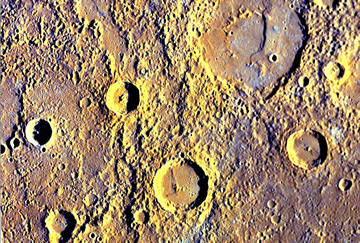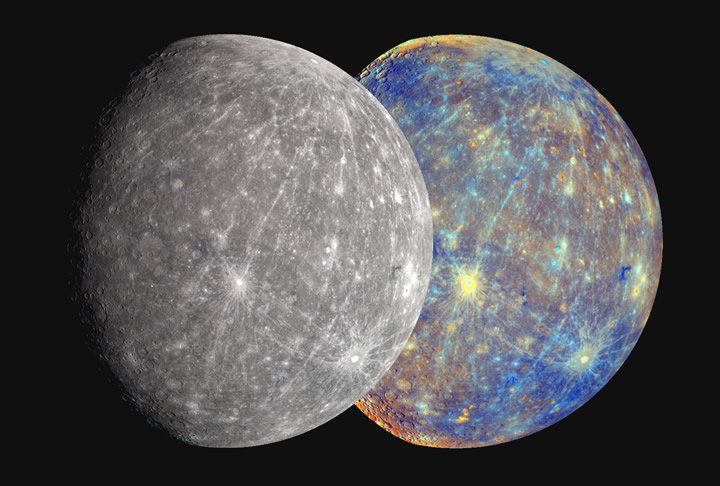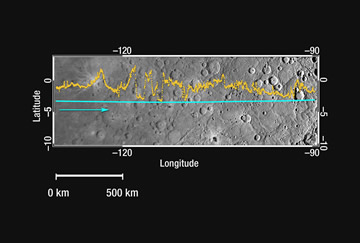[/caption]
Scientists from the MESSENGER mission to Mercury discussed today the results from the spacecraft’s October 6 flyby of the closest planet to the sun. The probe has produced several science firsts and is returning hundreds of new photos and measurements of the planet’s surface, atmosphere and magnetic field. The images show a battered surface, and we now have pictures and data of parts of Mercury’s surface that have never been examined by a spacecraft. “The region of Mercury’s surface that we viewed at close range for the first time this month is bigger than the land area of South America,” said Sean Solomon, principal investigator and director of the Department of Terrestrial Magnetism at the Carnegie Institution of Washington. “When combined with data from our first flyby and from Mariner 10, our latest coverage means that we have now seen about 95 percent of the planet.”
The MErcury Surface, Space ENvironment, GEochemistry, and Ranging, or MESSENGER, spacecraft flew by Mercury shortly after 4:40 a.m. EDT, on Oct. 6. It completed a critical gravity assist to keep it on course to orbit Mercury in 2011 and unveiled 30 percent of Mercury’s surface never before seen by a spacecraft.
The spacecraft’s science instruments operated throughout the flyby. Cameras snapped more than 1,200 pictures of the surface, while topography beneath the spacecraft was profiled with a laser altimeter. The comparison of magnetosphere observations from the spacecraft’s first flyby in January with data from the probe’s second pass has provided key new insight into the nature of Mercury’s internal magnetic field and revealed new features of its magnetosphere. The magnetosphere is the volume surrounding Mercury that is controlled by the planet’s magnetic field.
It was discovered that the planet’s magnetic field is highly symmetric.
The probe’s Mercury Laser Altimeter, or MLA, measured the planet’s topography, allowing scientists, for the first time, to correlate high-resolution topography measurements with high-resolution images.
“The MLA collected altimetry in regions where images from MESSENGER and Mariner 10 data are available, and new images were obtained of the region sampled by the altimeter in January,” said Maria Zuber, co-investigator and head of the Department of Earth, Atmospheric, and Planetary Sciences at the Massachusetts Institute of Technology. “These topographic measurements now improve considerably the ability to interpret surface geology.”
The Mercury Atmospheric and Surface Composition Spectrometer observed Mercury’s thin atmosphere, known as an exosphere. The instrument searched for emissions from sodium, calcium, magnesium, and hydrogen atoms. Observations of magnesium are the first detection of this chemical in Mercury’s exosphere. Preliminary analysis suggests that the spatial distributions of sodium, calcium, and magnesium are different. Simultaneous observations of these spatial distributions, also a first for the spacecraft, have opened an unprecedented window into the interaction of Mercury’s surface and exosphere.

Spacecraft images also are revealing for the first time vast geologic differences on the surface.
“Now that MESSENGER’s cameras have imaged more than 80 percent of Mercury, it is clear that, unlike the moon and Mars, Mercury’s surface is more homogeneously ancient and heavily cratered, with large extents of younger volcanic plains lying within and between giant impact basins,” said co-investigator Mark Robinson of Arizona State University in Tempe.
Source: NASA



Just from reading the article, I thinks they’re doing a pretty good job of that.
Why are we waisting time on these dead planets. There should be missions to titan and europa or any other planetary body that doesn’t just have rocks and craters…
NASA has to do something to keep people from thinking Mercury is just the Moon in a different Solar System location.
A strange way for crater ejecta to make long white lines. Same as on the Moon but more so on Mercury. Is there any explanation?
i love these great images of unexplored solar system territory. it’s a painfully long wait until the spacecraft finally reaches orbit!
Maybe it isn’t so much dead planets as it is dead minds viewing them. We can learn much from these dead orbs.
While I agree there are certainly more interesting worlds to explore, Mercury has only had two probes sent to it in the last three and a half decades, so I don’t think we can call this a waste.
I await the day we have microtechnology that allows many small probes to be sent to every world like a cloud, each with its own specialized function. If a few get lost, the mission will not suffer.